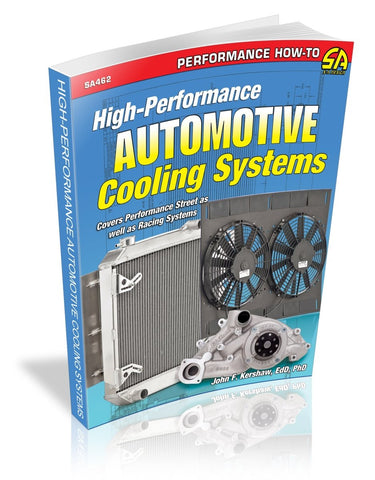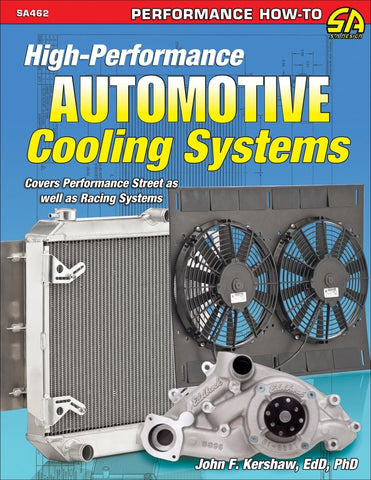Whether your vehicle is modified for the street or the track, keep its engine healthy by selecting the best cooling system components to match today’s horsepower demands.
In High-Performance Automotive Cooling Systems, author Dr. John Kershaw explains the basics of a cooling system’s operation, examines coolant and radiator options, explains how to manage coolant speed through your engine and why it is important, examines how to manage airflow through your radiator, takes a thorough look at cooling fans, and finally uses all this information in the testing and installation of all these components.
When considering how well modern cars perform in many areas, it is easy to forget some of the issues motorists had on a regular basis 40-plus years ago. Cars needed maintenance regularly: plugs and points had to be replaced on a frequent basis, the expected engine life was 100,000 miles rather than double and triple the expectation that you see today, and an everyday hassle, especially in warm climates, was being the victim of an overheating car. It was not uncommon on a hot day to see cars stuck in traffic, spewing coolant onto the ground with the hoods up in a desperate attempt to cool off.
Fast-forward to today, and it’s easy to forget that modern cars even have coolant. The temp needle moves to where it is supposed to be and never moves again until you shut the car off. For drivers of vintage cars, this level of reliability is also attainable.
Muscle cars and hot rod engines today are pushed to the limit with stroker kits and power adders straining the capabilities of your cooling system to extremes never seen before. Whether you are a fan of modern performance cars or a fan of more modern performance in vintage cars, this book will help you build a robust cooling system to complement your engine.
Acknowledgments
Preface
Chapter 1: Engine Cooling System Basic Operation
Thermodynamics
Thermodynamic Laws
Thermal Expansion
Pressure
Heat Transfer
Cooling System Operation
Cooling System Components
Chapter 2: Coolant Selection
Coolant Is Antifreeze and Water
Antifreeze Types
Antifreeze Components
Waterless Glycerol-Based Coolant
BeCool Coolant
Coolant Service
Chapter 3: Radiators
Radiator Design
Radiator Materials
Radiators Types
Pressurized Cooling System
Closed Cooling System
Aftermarket Overflow Tank
OEM Radiator Design and Testing
Radiator Selection
Radiator Inefficiency
Chapter 4: Coolant Flow
Centrifugal Water Pump Components
Centrifugal Water Pump Operation
Hydraulics
Water Pump Design Issues
Water Pump Construction
High-Performance Water Pumps
Electric Water Pumps
Thermostats
Thermostat Selection
Coolant Hoses
Chapter 5: Radiator Airflow
Airflow
Airflow to Remove Heat
Radiator Shrouds
Chapter 6: Cooling Fans
General Cooling Fan Information
Modified Stock and Race Car Cooling Fan Issues
Viscous Clutch
Electric Fans
Electric Cooling Fan Control
Cooling Fan Selection
Chapter 7: Basic System Diagnosis
Information Gathering
Inspections
Diagnostic System Checks
Intermittent Electrical Conditions
Isolate Root Cause, Repair, and Verify Fix
Engine Overheating Diagnostics
Pressure Testing a Cooling System
Thermostat Diagnosis
Thermostat Service
Checking Coolant Protection
Hose Service
Water Pump Service
Drive Belt Tension and Replacement
Radiator Replacement
Head Gasket Replacement
Heater Core Replacement
Cooling System Design and Service Issues
Chapter 8: Installation
Coolant System Flow Review
Wiring Harness
Water Pump Selection
Water Pump Installation
Thermostat, Inlet, and Outlet Selection
Coolant Hoses
Radiator Selection
Electric Cooling Fans
Expansion and Overflow Tanks
Coolant
Whether your vehicle is modified for the street or the track, keep its engine healthy by selecting the best cooling system components to match today’s horsepower demands.
In High-Performance Automotive Cooling Systems, author Dr. John Kershaw explains the basics of a cooling system’s operation, examines coolant and radiator options, explains how to manage coolant speed through your engine and why it is important, examines how to manage airflow through your radiator, takes a thorough look at cooling fans, and finally uses all this information in the testing and installation of all these components.
When considering how well modern cars perform in many areas, it is easy to forget some of the issues motorists had on a regular basis 40-plus years ago. Cars needed maintenance regularly: plugs and points had to be replaced on a frequent basis, the expected engine life was 100,000 miles rather than double and triple the expectation that you see today, and an everyday hassle, especially in warm climates, was being the victim of an overheating car. It was not uncommon on a hot day to see cars stuck in traffic, spewing coolant onto the ground with the hoods up in a desperate attempt to cool off.
Fast-forward to today, and it’s easy to forget that modern cars even have coolant. The temp needle moves to where it is supposed to be and never moves again until you shut the car off. For drivers of vintage cars, this level of reliability is also attainable.
Muscle cars and hot rod engines today are pushed to the limit with stroker kits and power adders straining the capabilities of your cooling system to extremes never seen before. Whether you are a fan of modern performance cars or a fan of more modern performance in vintage cars, this book will help you build a robust cooling system to complement your engine.
Acknowledgments
Preface
Chapter 1: Engine Cooling System Basic Operation
Thermodynamics
Thermodynamic Laws
Thermal Expansion
Pressure
Heat Transfer
Cooling System Operation
Cooling System Components
Chapter 2: Coolant Selection
Coolant Is Antifreeze and Water
Antifreeze Types
Antifreeze Components
Waterless Glycerol-Based Coolant
BeCool Coolant
Coolant Service
Chapter 3: Radiators
Radiator Design
Radiator Materials
Radiators Types
Pressurized Cooling System
Closed Cooling System
Aftermarket Overflow Tank
OEM Radiator Design and Testing
Radiator Selection
Radiator Inefficiency
Chapter 4: Coolant Flow
Centrifugal Water Pump Components
Centrifugal Water Pump Operation
Hydraulics
Water Pump Design Issues
Water Pump Construction
High-Performance Water Pumps
Electric Water Pumps
Thermostats
Thermostat Selection
Coolant Hoses
Chapter 5: Radiator Airflow
Airflow
Airflow to Remove Heat
Radiator Shrouds
Chapter 6: Cooling Fans
General Cooling Fan Information
Modified Stock and Race Car Cooling Fan Issues
Viscous Clutch
Electric Fans
Electric Cooling Fan Control
Cooling Fan Selection
Chapter 7: Basic System Diagnosis
Information Gathering
Inspections
Diagnostic System Checks
Intermittent Electrical Conditions
Isolate Root Cause, Repair, and Verify Fix
Engine Overheating Diagnostics
Pressure Testing a Cooling System
Thermostat Diagnosis
Thermostat Service
Checking Coolant Protection
Hose Service
Water Pump Service
Drive Belt Tension and Replacement
Radiator Replacement
Head Gasket Replacement
Heater Core Replacement
Cooling System Design and Service Issues
Chapter 8: Installation
Coolant System Flow Review
Wiring Harness
Water Pump Selection
Water Pump Installation
Thermostat, Inlet, and Outlet Selection
Coolant Hoses
Radiator Selection
Electric Cooling Fans
Expansion and Overflow Tanks
Coolant










